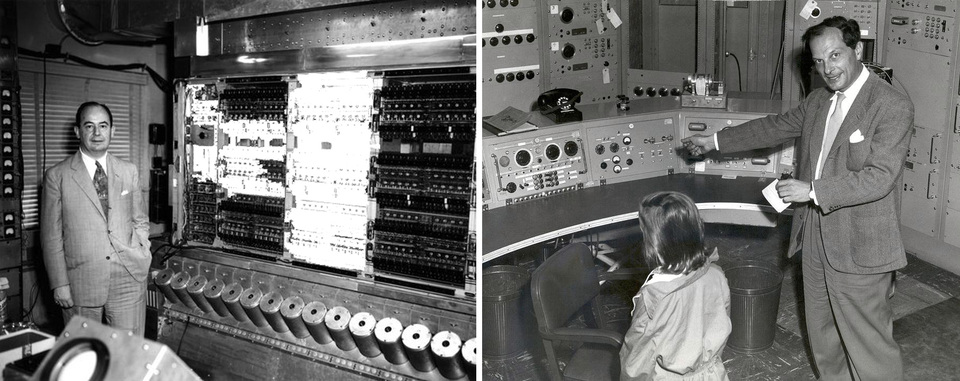John von Neumann (1903-1957) and Stanislaw Ulam (1909-1984) are likely the very first people to have understood the potential of computers in mathematics and physics [1] :
“Almost immediately after the war Johny and I also began to discuss the possibilities of using computers heuristically to try to obtain insights into questions of pure mathematics. By producing examples and by observing the properties of special mathematical objects one could hope to obtain clues as to the behavior of general statements which have been tested on examples. In the following years in a number of published papers, I have suggested – and in some cases solved – a variety of problems in pure mathematics by such experimenting or even merely ‘observing’ [2].”
Ulam’s vision was influenced by physics, more specifically by the numerical studies of simplified models of neutron diffusion (linked to the atomic bomb). Let us mention in passing that the very first calculations for a chain reaction were made by Nicholas Metropolis in 1947 on ENIAC [3].
In a text of 1947 titled The Mathematician [41], von Neumann emphasizes that there is an empirical basis to mathematics which was overshadowed by their axiomatical development. He says : “when it shows signs of becoming baroque, then the danger signal is up” and “when this stage is reached, the only remedy seems to me the rejuvenating return to the source : the reinjection of more or less directly empirical ideas.”

In this spirit, Ulam aimed at developing a practice of numerical experiments, starting with combinatorics and number theory. Then he turned with his collaborators to the exploration of the behavior of the iterations of nonlinear transformations which are the counterpart in discrete time to ordinary differential equations [4]. They use a device (an oscilloscope !) connected to the computer which allows the visualization of orbits – a new way to study nonlinear iterations that seems so obvious nowadays. An example of this approach is found in the paper [5] from which we extracted a few plots (see the figure below). They used an IBM 7030 “STRETCH” available at the Los Alamos Scientific Laboratory.
In his book [38], published in 1960, Ulam clearly outlines what we nowadays call “interactivity” (between the user and the computer), which he calls “synergesis”. In the chapter titled Computing Machine as a Heuristic Aid, he writes :
“ Instead of using the machine as a robot or, as it were, as a player piano whose tunes are written in advance, the machine kept in constant communication with an intelligent operator who changes even the logical nature of the problem during the course of a computation, at will, after evaluating the results which the machine provides. Of course such possibilities exist already, but to a very limited [6] extent. [...] Obviously for activities of this sort, a rapid access to the machine is necessary [...]. Also, the machine has to provide a quick illustration and display of the computed quantities and figures.”
